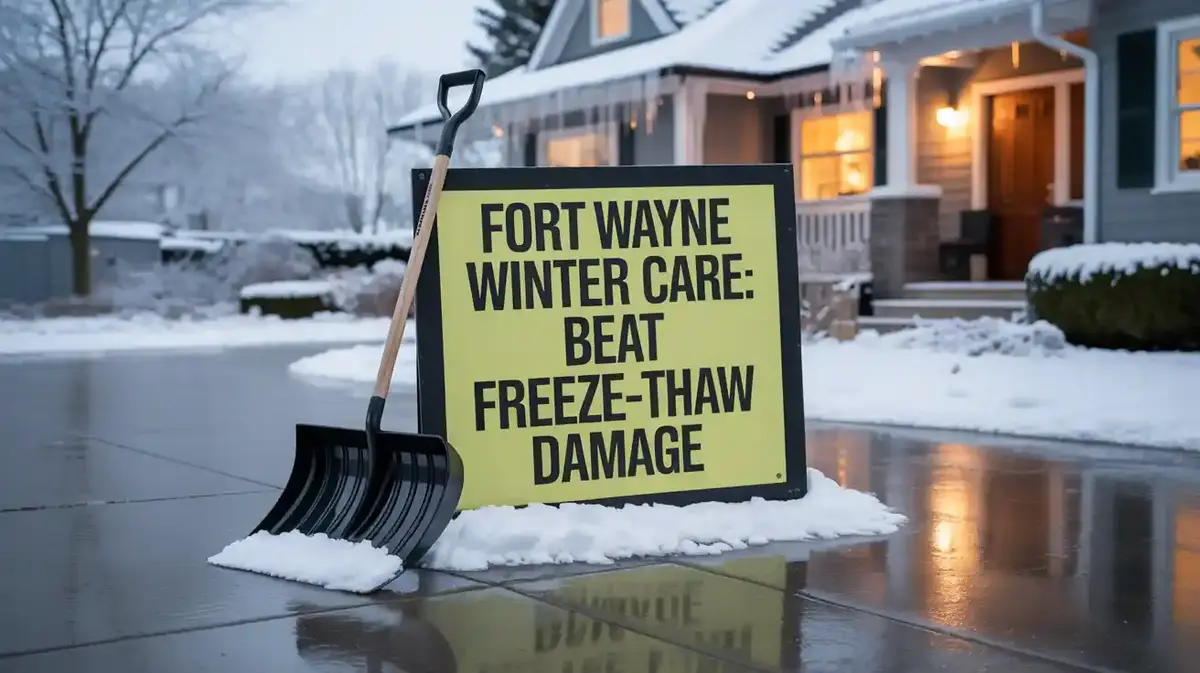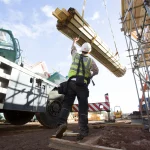Every winter, Fort Wayne homeowners watch helplessly as their concrete driveways and walkways develop new cracks and chips. The culprit? Indiana’s brutal freeze-thaw cycles that can destroy even well-built concrete surfaces. But here’s the thing – most of this damage is completely preventable with the right approach.
Finding a reliable concrete contractor in Fort Wayne who understands local conditions makes all the difference, but protecting your existing investment starts with understanding what you’re up against.

Content
Why Fort Wayne’s Weather Is Concrete’s Worst Enemy
Indiana winters aren’t just cold – they’re unpredictable. One day it’s 15°F, the next it’s pushing 45°F. This constant temperature swing creates the perfect storm for concrete damage.
When water seeps into concrete pores and freezes, it expands by 9%. That might not sound like much, but multiply that force across thousands of tiny spaces, and you’ve got enough pressure to crack even thick concrete slabs. The real problem starts when concrete reaches 90% pore saturation – at that point, there’s nowhere for the expanding ice to go except through your concrete.
Fort Wayne’s climate creates more freeze-thaw cycles than steady cold regions. While Minnesota might stay frozen for months, we get these constant temperature swings that repeatedly stress concrete surfaces. Add in our humidity and frequent precipitation, and you’ve got a recipe for expensive repairs.
The damage timeline is predictable: small cracks appear in November, worsen through December and January, then really show themselves when spring arrives. By then, what started as hairline cracks have become chunks of missing concrete – what professionals call spalling.
The Real Cost of Ignoring Winter Damage
Let’s talk numbers. Minor crack repair might cost a few hundred dollars, but full concrete replacement? You’re looking at $6-10 per square foot in Fort Wayne. For a typical two-car driveway, that’s $3,000-5,000 or more.
But money isn’t the only concern. Damaged concrete creates trip hazards, especially for elderly family members or guests. Uneven surfaces can damage car tires or suspension components. Water that infiltrates through cracks can eventually reach your foundation, creating much bigger problems.
Your home’s value takes a hit too. Cracked, spalling concrete screams “deferred maintenance” to potential buyers. Real estate agents know that damaged driveways and walkways are red flags that suggest other hidden problems.
Your Fall Protection Game Plan
September and October are your concrete’s best friends. This is when you can actually do something about winter damage before it happens.
Start with a thorough inspection. Look for any cracks, no matter how small. Check where water might pool or where drainage seems poor. Clean off any debris, leaves, or dirt that could trap moisture against the concrete surface.
Small cracks can be sealed now, but once temperatures drop below 50°F consistently, most repair materials won’t cure properly. This narrow window is why fall preparation matters so much.
Sealing is your secret weapon, but timing is everything. The ideal temperature range is 50°F-75°F with low humidity. In Fort Wayne, that usually means mid-September through early October. Miss this window, and you’re gambling with winter weather.
Penetrating sealers work better than surface sealers for our climate. They soak into the concrete and create a barrier from the inside out, rather than just coating the surface where they can peel or wear off.
Winter Maintenance That Actually Works
Once winter hits, your strategy shifts to damage control. Snow removal becomes a delicate balance – you need to get it off quickly, but not damage the concrete in the process.
Remove snow immediately after it falls, before it has a chance to melt and refreeze. Use plastic shovels or snow pushers rather than metal ones that can scratch and gouge the surface. If you must use a metal shovel, keep it at a slight angle to avoid scraping.
Here’s where most people mess up: de-icing. Rock salt is concrete’s enemy. It doesn’t just melt ice – it penetrates concrete and creates internal pressure that leads to scaling and spalling. The salt literally eats your concrete from the inside out.
Sand provides traction without chemical damage. Cat litter works too, though it’s messier in spring. If you must use a de-icer, look for products specifically labeled as concrete-safe. They cost more upfront but save thousands in repairs.
Apply any de-icing material sparingly. More isn’t better – it’s more destructive.
When Professional Installation Makes the Difference
Not all concrete is created equal, especially when it comes to surviving Indiana winters. Gleave Construction has spent over 50 years perfecting concrete installation techniques that stand up to Fort Wayne’s harsh climate.
Air-entrained concrete contains millions of microscopic bubbles that give expanding ice somewhere to go. It’s like built-in shock absorbers for freeze-thaw cycles. Proper thickness and reinforcement matter too – thin concrete without adequate support will crack under pressure.
Drainage integration during installation prevents water from pooling and saturating the concrete. Quality control during the curing process ensures the concrete reaches full strength before facing its first winter.
Experience with local conditions matters. Soil types, typical weather patterns, and regional best practices all influence how concrete should be installed and maintained.
Recognizing When You Need Professional Help
Some problems are beyond DIY fixes. Structural cracks that run the full depth of the concrete indicate serious issues. Spalling that exposes aggregate or reinforcement means the damage has progressed too far for simple repairs.
If you’ve tried fixing the same area multiple times, that’s a sign of underlying problems that need professional diagnosis. Settlement cracks, where one section of concrete has moved relative to another, require specialized repair techniques.
The cost of waiting grows exponentially. A $200 crack repair becomes a $2,000 section replacement, which becomes a $5,000 full driveway replacement. Emergency repairs during winter cost more and often don’t last because of weather limitations.
Your Year-Round Protection Strategy
Successful concrete maintenance follows a seasonal rhythm. Spring means assessment and planning. Summer is for major repairs and preparation. Fall is sealing and winterization time. Winter requires vigilant monitoring and careful maintenance.
Building a relationship with concrete professionals pays dividends. Annual inspections catch problems early when they’re still affordable to fix. Maintenance contracts provide predictable costs and priority service when problems arise.
Think of concrete care like car maintenance – regular attention prevents expensive breakdowns. The difference is that concrete lasts decades when properly maintained, making the investment worthwhile.
Protecting Your Investment
Fort Wayne’s freeze-thaw cycles are relentless, but they’re not unstoppable. The key is understanding what you’re fighting and taking action before damage occurs. Fall preparation, winter vigilance, and professional expertise when needed will keep your concrete looking good and functioning properly for years to come.
Your concrete investment deserves protection. With the right approach, you can beat Indiana’s harsh winters and avoid the costly repairs that catch so many homeowners off guard. The question isn’t whether freeze-thaw damage will occur – it’s whether you’ll be ready for it.

Christine Kelley is a dedicated home blogger who has been blogging for over six years. She covers everything home related. Christine also loves writing posts about her travels to Europe with her husband and two children.






